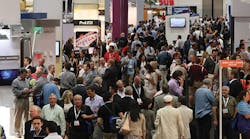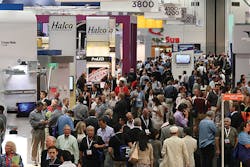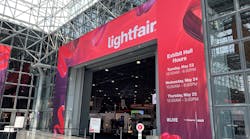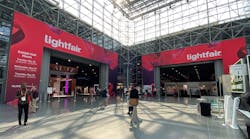Celebrating its 25th anniversary, LIGHTFAIR International brought together more than 26,000 industry professionals to see the latest lighting products and services at the Las Vegas Convention Center from June 1-5. The biggest movement in the industry appears to be interconnecting solid-state lighting products to achieve maximum energy savings while also providing a lighting system that fosters productivity and increases the quality of life.
The quality of LED chips and their drivers are also a major source for change, because as the cost of these inherently-controllable LED chips declines, and the adoption rate of new fixtures increases, tiny sensors and control components, shrunk to the size of a pencil point, provide daylight dimming, color optimization, occupancy detection, lumen management and detection of environmental conditions such as temperature and CO2 levels in the vicinity of fixtures. Since these conditions, or readings, can be stored, essentially every LED fixture can be a node on a controls/communications network. Sensors, cameras, location data, user identification and a host of other elements will be the eyes and ears of the environment, privacy concerns notwithstanding. Thus, solid-state lighting may have a commanding lead in the Internet of Things (IoT) age, if impressions from the exhibit floor are correct.
Showcasing wireless networks
Smart lighting is another term for this marriage between electronics and networking that permits value-added features to be added to “just plain” lighting, through both wired and wireless communication systems. While the industry lacks anything approaching a standards-based lighting network protocol, because of improvements in software and reliability, a lot of the attention focuses on three wireless protocols: ZigBee, Bluetooth and WiFi.
To address this growing market, the Connected Lighting Alliance is proposing an open wireless connectivity standard for indoor commercial lighting, following its endorsement of ZigBee Light Link as the preferred open standard for residential connected lighting. In this regard, Daintree Networks, with its ControlScope ZigBee-based system, demonstrated wireless adapters that can be retrofitted into LED fixtures, and showed occupancy sensors from Philips Lighting — the OccuSwitch Wireless Occupancy Sensor that combines a sensor and a ZigBee-enabled wall switch. Daintree is also partnered with LG Electronics for their LED ceiling troffers.
In addition to showcasing ZigBee-based lighting, Samsung also had Bluetooth Smart LED A19 replacement bulbs which don’t need a bridge to achieve mesh connectivity for up to 64 lamps within a maximum range of 2,000 feet. The system offers dimming and color “tunability” similar to Philips’ Hue and Connected by TCP. These lamps have particular applications in hospitality and health care environments.
Cree Lighting demonstrated its SmartCast Technology, a self-programming wireless lighting control system that allows for daylight harvesting and vacancy sensing without extra devices. At the same time, Cree is integrating Lutron's proprietary EcoSystem wired network scheme in the CR-family of troffers. Most likely, the EcoSystem will be supported in other controlled lighting products.
Acuity Brands, Inc. had five lighting control product lines within 18 vignettes that replicate typical indoor and outdoor settings, since people have different color needs according to their work or leisure requirements. The firm’s xCella wireless control system handles lighting, HVAC and plug loads, using battery-free, power harvesting technology, to provide single-room control. The XPoint wireless control system can create a hybrid wired/wireless system, when combined with other Acuity Controls products.
Cooper Lighting introduced a wireless-based lighting control system, based on the recently ratified IEEE 802.11ac Radio Frequency (RF) Wi-Fi standard, which includes a battery-operated Wi-Fi occupancy sensor with a 10-year battery life. The new 802.11ac standard is faster, goes farther and is more secure than the predecessor 802.11n standard, which brought improvements in data rates and link efficiencies.
EnOcean Alliance, a consortium of over 350 companies, showed the latest line of energy-harvesting (power for communications is collected from motion, indoor light and temperature differentials), battery-less wireless devices, such as dimmers, occupancy sensors, photo-sensors, relay receivers, light switches, key card switches, LED controls, load control modules and gateways. License-free 868 MHz, 315 MHz, 902 MHz and 928 MHz frequency bands are accommodated.
Boosting control features
A host of products from Wattstopper, Legrand, Osram Sylvania, GE Lighting, Lutron, Sensity, Philips, Hubble Lighting, Juno Lighting, Digital Lumens, USAI, Lighting Science, FX Luminaire, Lumenpulse and others showed communications/control systems featuring smaller, more economical modular chips, or drivers, and sensing options. These systems can tailor the “color feel” of a lighting system to create whatever visual environment is desired, many of them using a touchscreen or a mobile device to define scenes, adjust zones and blend intensity, color appearance and color temperature.
Leviton expanded its suite of daylight harvesting solutions with an Integrated Room Control (IRC) system that combines daylight harvesting, 0V to 10V dimming and demand response capabilities for two or three zones. It also showed its line of LevNet 902MHz wireless control devices for BMS, occupancy detection, multi-location switching and motor loads. The ProVot occupancy sensor handles all load types and features a mechanically-held 10A latching relay.
NexLight, a provider of relay-panel-based lighting control systems, released its line of dual-mode occupancy sensors designed to meet Title 24 and ASHRAE 90.1 2010 requirements. ZigBee wireless control can be used alone or integrated into the two-wire bus that supports BACnet, MODBus, LonWorks, TCP/IP and DALI protocols.
Lutron’s Quantum Vue facility management tool allows a building to use a desktop, a tablet, or a smartphone to manage buildings and campuses remotely. An operator can view and adjust the lighting zones and automated shades in specific areas of a building while the client can visualize energy savings through expanded reporting that includes their savings per strategy.
Assisting retail sales
This year, lighting fixtures are able to features GPS-type location systems for retail application. With more than 60% of mobile shoppers using smartphones while in-store, and 85% of consumers using retailers’ native apps or other websites during shopping trips, retailers can now use a lighting system capable of providing marketing assistance.
GE Lighting is working with visual light communications startup ByteLight to develop networked lighting fixtures that, in conjunction with a Bluetooth Low Energy (BLE) wireless communications system, can communicate with a smartphone. BLE is used initially when there is no line-of-sight link between the overhead LED fixture and the phone. The camera of a smart phone, with ByteLight’s software, receives light from the lighting system as a modulated or coded signal (undetected by the human eye) that has information useful to the shopper, such as targeted ads.
Acuity Brands’ visual light communication system may be the product closest to market. Using Lumicast technology from Qualcomm Technologies, Inc., a subsidiary of Qualcomm Inc., the system can pinpoint a shopper’s location to within 10 centimeters on the sales floor. Philips has its Connected Lighting systems, which can deliver in-context information and applications, such as indoor wayfinding and personal couponing for retailers. The system can also be used in commercial offices to record occupancy in conference rooms and other environmental data for integration into a larger building control system. The LED light fixtures receive power from the building’s IT network cabling following the Power-over-Ethernet (PoE) standard.
Indoor fixture applications
Global Lighting Technology, a pioneer in flat panel, edge-lit, light extraction technology, showed a 2 by 2 ft replacement fixture for a fluorescent ceiling troffer. Cooper Lighting showcased its similar WaveStream flat panel blades that are used in a wide variety of brands for retail, commercial and industrial applications. Its Metalux high-bay industrial luminaire, provides more than 200 lumens per watt and up to 70,000 delivered lumens. Lighting Science has a ceiling troffer that provides a specific spectral content able to reinforce our natural circadian rhythm.
The EMerge Alliance modular low-voltage DC power distribution system is now incorporated into Article 393 of the National Electrical Code (NEC), adding to the validity of integrating power, control and devices into a common DC system as an adjunct to AC power in a variety of facilities.
Outdoor lighting
LEDs continue to bring energy-saving, high-output illumination to outdoor spaces from campus walkways to highways and parking lots. Osram Sylvania’s PermaLED Area light, available in three wattages, can be specified with either a photo sensor or dual technology motion and photo-control sensor. GE’s Evolve LED Area Light has a variety of lumen outputs and a wide selection of photometric distributions. Lighting Science demonstrated its 65W Roadmaster LED-based street light that eliminates the electrolytic capacitor at the output of the driver, thus removing a failure point and reducing cost.
LED street lighting with RF-wireless lighting controllers and GPS/GSM technology offers many asset management features. Philips is promoting its CityTouch Light Point & LightWave system for street lighting and, seeing the potential to generate revenue at each pole, is partnering in Europe with Ericsson to allow network service providers to set up mobile broadband service. GE Lighting’s LightGrid outdoor wireless control system for its roadway luminaires can report operational data, such as energy consumption via a web-based interface. Additional software capability includes scheduling, customized reporting, grouping and user access level management. Adding to the trend, Cooper Lighting has the LumaWatt wireless network and control platform for outdoor LED-based lighting. Based on the IEEE 802.15.4 standard (ZigBee) for a mesh configuration, it uses a proprietary set of layers on top the standard to achieve 128-bit encryption.
Hubbell Outdoor Lighting Brands’ Sterner RT-21 LED fixture uses TOTUS Solutions’ Active Deterrence surveillance system to provide security in the form of video monitoring, two-way audio communications and advanced site analytics. Lighting Science has the PixelView Control system that uses image sensing and video processing to accurately detect and characterize motion.
Replacement sources
Replacement lamps of all types were seen throughout the exhibit floor, with the LED incandescent retrofit (A, PAR and other types) continuing as the most significant sector, and many can dim to a warm CCT and mimic a tungsten halogen lamp. Osram Sylvania, for example, had a new version of the Ultra SE (sunset effect) A-Line product, and the Sylvania Ultra Professional LED PAR lamp family has a new lens design for improved field angle and beam characteristics. Soraa, which has an initial line of MR16 replacement lamps that use a GaN on GaN process, showed an expanded line of AR111 and PAR30/38 lamps. Lighting Science Group revealed a line of biologically-corrected LED lamps for commercial and residential applications.
This year, direct replacement LED products for both linear and U-tube fluorescent lamps, with high lumen outputs and lifetimes, were seen in abundance. It seems that the challenge presented by the need for heat dissipation has been resolved, so Philips, GE Lighting, Sylvania, CREE, Maxlight, American Bright and others can replace many fluorescent T8 lamp models. The replacement is a simple swap-out of the existing fluorescent lamps, with no rewiring necessary.
The T8 replacement tubes from Philips, in both linear and bent tube models, have a beam angle of 160°, and are available in four color temperatures, using 14.5W to provide either 1,500 or 1,650 lumens. The lifetime is 40,000 hours, and a 4-year warranty is offered. The Cree LED T8 Series is available in 3,500K and 4,000K color temperatures, with a CRI of 90 and a 50,000 hr life. In addition, MaxLite has a line of LED PL retrofit replacements lamps with both double pin and GU 24 bases for compact fluorescent lamps.
Sylvania’s ModuSYS LED conversion kit for general illumination and fluorescent replacement applications features a removable diffuser; its Ultra HE T8LED retrofit kit (lamp and driver) delivers up to 2,450 lumens at 19W. Kenall has a retrofit kit to upgrade its wet location, sealed enclosure fixtures with a linear LED source, while retaining the fixture warranty.




